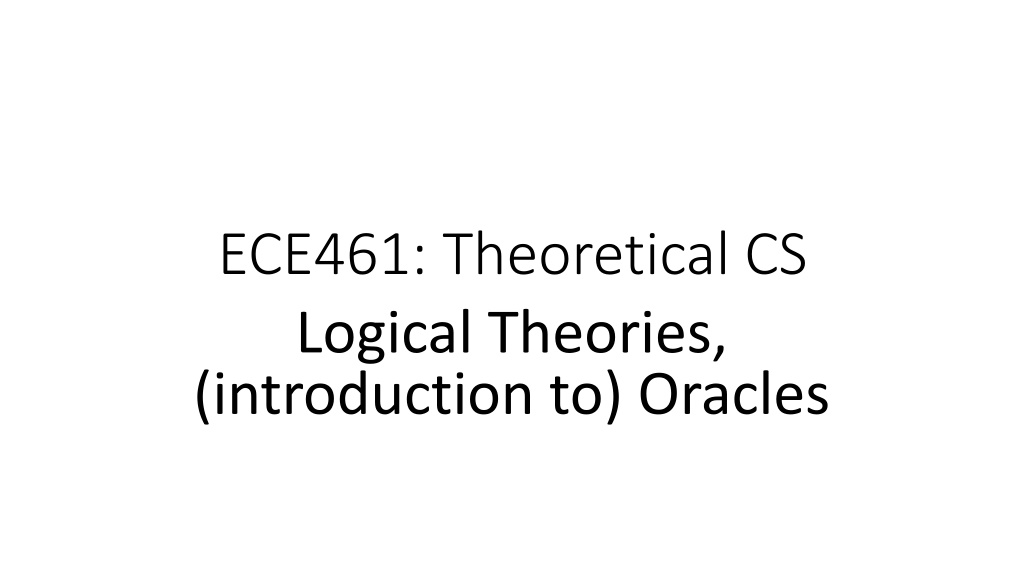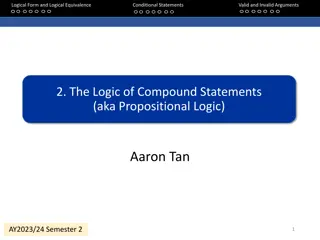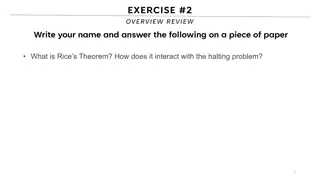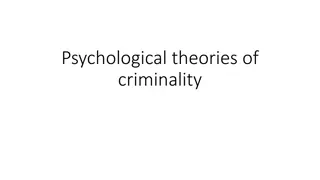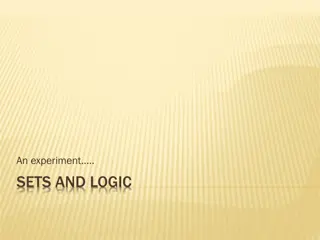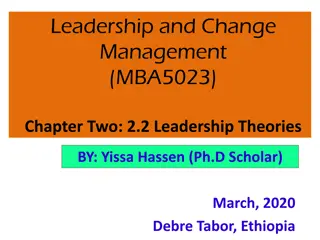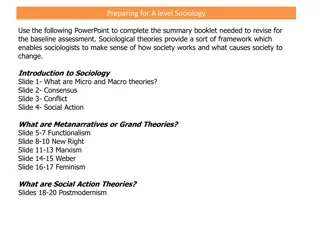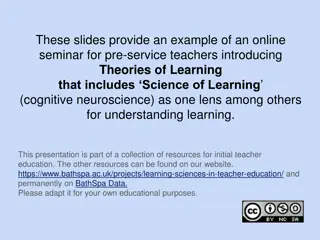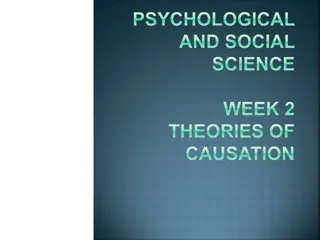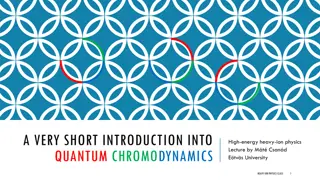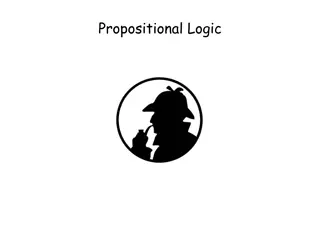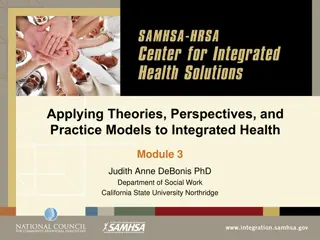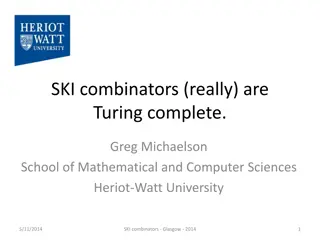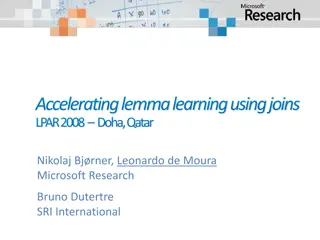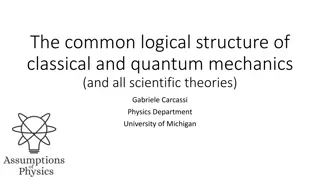Exploring Logical Theories in Computability
In this topic, we delve into logical theories and their relationship with Turing machines, focusing on the decidability of mathematical statements. We analyze examples of logical statements within the context of first-order logic, also known as predicate logic or predicate calculus.
Download Presentation

Please find below an Image/Link to download the presentation.
The content on the website is provided AS IS for your information and personal use only. It may not be sold, licensed, or shared on other websites without obtaining consent from the author.If you encounter any issues during the download, it is possible that the publisher has removed the file from their server.
You are allowed to download the files provided on this website for personal or commercial use, subject to the condition that they are used lawfully. All files are the property of their respective owners.
The content on the website is provided AS IS for your information and personal use only. It may not be sold, licensed, or shared on other websites without obtaining consent from the author.
E N D
Presentation Transcript
ECE461: Theoretical CS Logical Theories, (introduction to) Oracles
Brief Recap In our recent topics, we have been discussing Turing machines (TMs), providing us with the most powerful known formalism for modeling computation If we accept the Church-Turing thesis, all algorithms can be implemented by Turing machines However, we have seen that Turing machines are not without limits In particular, some languages are undecidable, and some languages are not Turing-recognizable All the topics mentioned above are related to computability theory, the subject of the second of three parts of our textbook Chapter 6, the final chapter of this part, is titled "Advanced Topics in Computability Theory" In our previous topic, we covered the recursion theorem, related to Section 6.1 of the textbook In this topic, we will discuss two subtopics: First, we will discuss logical theories, and how Turing machines allow us to think about them; this subtopic is related to Section 6.2 in the textbook, titled "Decidability of Logical Theories" Second, we will briefly introduce the concept of Turing reducibility, which also raises the concept of oracles; this subtopic is related to Section 6.3, titled "Turing Reducibility" (a very short section, under two pages) These subtopics are unrelated to each other; I'm combining them because the second one is short
Logical Statements Early in Section 6.2, the book says it will "focus on the problem of determining whether mathematical statements are true or false and investigate the decidability of this problem" Shortly after, they state, "we need to set up a precise language to formulate these problems" Having said that, they introduce examples of logical statements before they formalize the language they are using, and they never name the formalism they are using Looking at the logical statements, the book appears to be using first-order logic (FOL), a.k.a. predicate logic or predicate calculus (there are also other terms used by various sources) Three examples of "mathematical statements" (I'm referring to them more generally as logical statements) are then given in the book (I am using the same notation as the book here): 1. q p x,y p > q (x,y > 1 xy p) 2. a,b,c,n [(a,b,c > 0 n > 2) an+ bn cn] 3. q p x,y [p > q (x,y > 1 xy p xy p + 2 )] Note that these statements may look cryptic, but each has a meaning that is simple to express:
Logical Statements Early in Section 6.2, the book says it will "focus on the problem of determining whether mathematical statements are true or false and investigate the decidability of this problem" Shortly after, they state, "we need to set up a precise language to formulate these problems" Having said that, they introduce examples of logical statements before they formalize the language they are using, and they never name the formalism they are using Looking at the logical statements, the book appears to be using first-order logic (FOL), a.k.a. predicate logic or predicate calculus (there are also other terms used by various sources) Three examples of "mathematical statements" (I'm referring to them more generally as logical statements) are then given in the book (I am using the same notation as the book here): 1. q p x,y p > q (x,y > 1 xy p) 2. a,b,c,n [(a,b,c > 0 n > 2) an+ bn cn] 3. q p x,y [p > q (x,y > 1 xy p xy p + 2 )] Note that these statements may look cryptic, but each has a meaning that is simple to express: 1. There are infinitely many primes (the book says this was known since the time of Euclid, 2300 years ago)
Logical Statements Early in Section 6.2, the book says it will "focus on the problem of determining whether mathematical statements are true or false and investigate the decidability of this problem" Shortly after, they state, "we need to set up a precise language to formulate these problems" Having said that, they introduce examples of logical statements before they formalize the language they are using, and they never name the formalism they are using Looking at the logical statements, the book appears to be using first-order logic (FOL), a.k.a. predicate logic or predicate calculus (there are also other terms used by various sources) Three examples of "mathematical statements" (I'm referring to them more generally as logical statements) are then given in the book (I am using the same notation as the book here): 1. q p x,y p > q (x,y > 1 xy p) 2. a,b,c,n [(a,b,c > 0 n > 2) an+ bn cn] 3. q p x,y [p > q (x,y > 1 xy p xy p + 2 )] Note that these statements may look cryptic, but each has a meaning that is simple to express: 1. There are infinitely many primes (the book says this was known since the time of Euclid, 2300 years ago) 2. This is Fermat's last theorem (the book mentions that this proven by Andrew Wiles in 1994)
Logical Statements Early in Section 6.2, the book says it will "focus on the problem of determining whether mathematical statements are true or false and investigate the decidability of this problem" Shortly after, they state, "we need to set up a precise language to formulate these problems" Having said that, they introduce examples of logical statements before they formalize the language they are using, and they never name the formalism they are using Looking at the logical statements, the book appears to be using first-order logic (FOL), a.k.a. predicate logic or predicate calculus (there are also other terms used by various sources) Three examples of "mathematical statements" (I'm referring to them more generally as logical statements) are then given in the book (I am using the same notation as the book here): 1. q p x,y p > q (x,y > 1 xy p) 2. a,b,c,n [(a,b,c > 0 n > 2) an+ bn cn] 3. q p x,y [p > q (x,y > 1 xy p xy p + 2 )] Note that these statements may look cryptic, but each has a meaning that is simple to express: 1. There are infinitely many primes (the book says this was known since the time of Euclid, 2300 years ago) 2. This is Fermat's last theorem (the book mentions that this proven by Andrew Wiles in 1994) 3. There are infinitely many twin primes (the book mentions that this has never been proven true or false!)
The Alphabet of First-order Logic As pointed out earlier, although it doesn't name the formalism, I believe the textbook is using first-order logic (FOL) in this section; if not, it is using something similar The alphabet of the language includes: Boolean operations: , , and Parentheses: ( and ) Quantifiers: and (the book does not state it here, but these are pronounced "for all" and "there exists") Variables: p, q, x, y, Relations (some sources call these predicates): R1, R2, Some things I want to point out: The textbook doesn't list implication ( ) when they describe the alphabet, but they use it in their examples; technically, speaking, A B can be written as A B In the previous examples, the uses of >, mathematical operations, equality checking, and constants can be thought of as relations; we can use symbols when the meaning is clear (the section points this out later) FOL also allows functions that can be applied to variables, but our textbook does not mention this or use them (so perhaps this is really a subset of FOL, or some other similar logical formalism) Some sources split the alphabet of FOL into logical symbols (typically operations, parentheses, quantifiers, and variables) and non-logical symbols (relations and functions), but that's not important for our purposes
The Syntax of First-Order Logic An atomic formula of FOL is a relation applied to the proper number of arguments, having the form Ri(x1, x2, , xj) The value, j, is called the arity of the relation Ri A well-formed formula, or just formula, of FOL can consist of: An atomic formula An expression of the form 1 2, 1 2, or 1, where 1and 2are smaller formulas An expression of the form xi[ 1] or xi[ 1], where 1is a smaller formula The book doesn't list it here, but parentheses may be used where appropriate (the book also uses brackets the same way in some examples) A quantifier may appear anywhere, and its scope extends to the end of the innermost parentheses or brackets Formulas with all quantifiers at the start are said to be in prenex normal form; the book doesn't explicitly state it, but any FOL formula can be converted to prenex normal form If any variables are not bound by a quantifier, they are called free variables A formula without any free variables is called a statement or a sentence
The Semantics of First-Order Logic To interpret an FOL statement, we need to know the following: The domain (a.k.a. universe) of the variables (often assumed to be the same for each variable) The assignment of relations to relation symbols (i.e., the meaning of each relation) When everything necessary is specified, we call that a model, a.k.a. an interpretation Note that each properly expressed relation, when values are filled in, will be either true or false Similarly, each statement (a.k.a. sentence) is either true or false; note that whether a particular statement is true or false may depend on the model (we will see examples that should help clarify this on the next slide) Collectively, the statements (both true and false) that can be specified given a model, M, is said to be the language of the model, denoted L(M) The collection of true statements given a model, M, is said to be the theory of M, denoted Th(M) I would also like to point out: FOL has also been popular in the field of computational linguistics to represent the semantics (often defined as the study of meaning) of natural language sentences; our textbook does not use the term "semantics" In such cases, constants and variables can refer to real-world entities (e.g., people, locations, restaurants, etc.), and relations can represent various high-level concepts In the textbook, FOL is just used to reason about logical and mathematical theories; variables will typically refer to either integers, and the relations will typically represent mathematical or logical concepts
Examples of Statements and Models Consider the statement: x,y R1x,y R1y,x This may be true or false, depending on the model If the model is M1= (N, ), where N is the set of natural numbers, then the statement is true If the model is M1= (N, <), then the statement is false (it fails when x and y are equal) If we know the model is M1= (N, ), we can rewrite the statement as: x,y x y y x Now consider the statement: y x R1x,x,y We will assume that R1is the relation, PLUS, where PLUS(a, b, c) = TRUE iff a + b = c Thus, we can rewrite the statement as: y x x + x = y Still, the statement may be true of false, depending on the model If the model is M2= (R, PLUS), where R is the set of real numbers, then the statement is true If the model is M2= (N, PLUS), then the statement is false (it would fail for odd values of y)
A Decidable Theory The book introduces the model (N, +) This means that variables all have the domain of the natural numbers, and the only relation that can be used is PLUS, as previously defined The theory of this language, denoted Th(N, +), consists of all true statements that can be formed using natural numbers and PLUS Theorem 6.12 states: "Th(N, +) is decidable" Clearly, determining if a statement is a member of this language is equivalent to determining if the statement is both valid and true, given the model Note that this theorem is not obvious! Recall that the statements can include quantifiers, and the domains of variables are infinite The textbook provides a proof of Theorem 6.12 The proof partly relies on a generalization of the solution to Problem 1.32, from the first problem set (you proved that Boolean addition statements expressed in a certain format forms a regular language) I consider this proof very complicated, and I had to read through it several times to understand it We are not going to cover this proof in class, and I won't hold you responsible for it
An Undecidable Theory Next, the book introduces the model (N, +, *) This means that variables all have the domain of the natural numbers, and the two relations that can be used are relations representing addition and multiplication The theory of this language, denoted Th(N, +, *), consists of all true statements that can be formed using natural numbers, addition, and multiplication Theorem 6.13 states: "Th(N, +, *) is undecidable" As with Theorem 6.12, determining if a statement is a member of this language is equivalent to determining if the statement is both valid and true, given the model However, the proof of this theorem relies on a lemma, and the book states that the proof of the lemma is "too complicated to present here" Lemma 6.14 states: "Let M be a Turing machine and w a string. We can construct from M and w a formula M,win the language of (N, +, *) that contain a single free variable x, whereby the sentence x M,wis true iff M accepts w." In the "proof idea" (which is all that is given), the book explains that the statement M,wcan be interpreted to express that x (the only free variable in M,w) represents an accepting computation history of M on w Given the lemma, the proof of Theorem 6.13 is simple and straightforward A Turing machine can construct the formula M,w, based on M and w, and output the statement x M,w This is a mapping reduction from ATMto Th(N, +, *) relying on computation histories If Th(N, +, *) were decidable, we could then use its decider to solve ATM; hence, Th(N, +, *) is not decidable
Formal Proofs The book briefly discusses some facts about formal proofs; the book states: "Loosely speaking, the formal proof of a statement is a sequence of statements, S1, S2, , Sl, where Sl= . Each Sifollows from the preceding statement and certain basic axioms about numbers, using simple and precise rules of implication." The book points out that they "don't have the space to define the concept of proof" However, they state "two reasonable properties of proofs" that will be true for well-defined mathematical and logical systems: "The correctness of a proof of a statement can be checked by machine. Formally, {< , > | is a proof of } is decidable." "The system of proofs is sound. That is, if a statement is provable (i.e., has a proof), it is true." Given these properties, the book states Theorem 6.15: "The collection of provable statements in Th(N, +, *) is Turing-recognizable" This is because a TM can iterate through all possible strings given its alphabet; in Chapter 0, the textbook referred to this as lexicographic order (in DSA II, we called such a sequence a lexicographical ordering) For each string, the TM can check if the string represents a valid proof, based on the first property above By the second property, if the proof is sound, the final statement is is a true, provable statement A TM can use this algorithm, P, to search for a proof of a statement, ; if there is one, the TM will find it
Gdel's Theorem (part 1) Next, we will discuss G del's theorem, a.k.a. G del's incomplete theorem, or the first of two of G del's incompleteness theorems First, let's recall some terminology related to this from DSA II: Informally, a complete system of arithmetic is one such that every true statement that can be expressed by the language can theoretically be proven within the language Informally, a consistent system of arithmetic is one that does not contradict itself In 1931, Kurt G del proved that no system capable of expressing all basic facts of arithmetic can be both consistent and complete For any consistent, formal system capable of expressing all basic arithmetical facts, there must be certain true statements expressible by the language that cannot be proven within the language Less relevant to us is the G del's second incompleteness theorem, which states that no adequately expressive system of arithmetic can prove its own consistency (we will not discuss this further) For systems of math or logic that are less powerful, G del's theorem may or may not apply We already learned, for example, that Th(N, +) is decidable; hence, the theorem does not apply, because it is possible to determine, with certainty, if any valid statement is true or false However, we now know enough to simply show that G del's theorem does apply to Th(N, +, *) Earlier in the section, the book mentions that this was proven by Church, working off the work of G del
Gdel's Theorem (part 2) Theorem 6.16 states: "Some true statement in Th(N, +, *) is not provable." The (casual) proof of this, given what has already been covered, is a simple, indirect proof: Assume that all true statements in Th(N, +, *) are provable Consider a syntactically valid statement, ; recall that any such statement is either true or false If is true, then is false, and If is false, then is true; that is, exactly one of and is true The book says we can use the algorithm P, from the proof that the collection of provable statements in Th(N, +, *) is Turing-recognizable, "in parallel" on and Really, a TM would have to go back and forth between the two, increasing the depth of the search as it goes If all true statements were provable, we would eventually find a proof of either or That would make Th(N, +, *) decidable However, we already know that Th(N, +, *) is not decidable; hence, we have a contradiction Therefore, the assumption that all true statements in Th(N, +, *) are provable is false Hence, there must be at least one true statement in Th(N, +, *) that is not provable I personally find this very interesting This proof relies on the result of a previous proof involving a reduction from ATM This shows that two of the most important discoveries in the history of mathematics and computer science are strongly related to each other!
A True, Unprovable Statement (part 1) In DSA II, we discussed the true but unprovable statement that G del proved should be possible in any consistent, adequately expressive mathematical system Using the casual notation from DSA II, we expressed the sentence: Pk(k) = ~ x [ xproves Pk(k)] The meaning of this statement in English is, roughly, "There does not exist a proof of this statement", or "this statement is not provable" Our textbook introduces a statement that they say translates to "This sentence is not provable" (recall that "sentence", in this context, is synonymous to "statement") Theorem 6.17 states: "The sentence unprovable, as described in the proof, is unprovable" The proof asks us to consider a TM, S, that operates as follows: First, S obtains its own description via the recursion theorem S constructs this sentence, using Lemma 6.14 (which we covered a few slides back): = c [ s,0] We didn't prove Lemma 6.14 (neither does the book), but recall that c is the only free variable in s,0, and there exists a c that makes the statement true if and only if S accepts the input 0 (0 here was chosen arbitrarily) S then runs algorithm P from the proof of Theorem 6.15 (which we also covered), whereby we showed that the collection of provable statements in Th(N, +, *) is Turing-recognizable, to attempt to find a proof of If P finds a proof of , accept (if P does not find a proof, it will run forever) The textbook then renames , the statement indicated above, as unprovable
A True, Unprovable Statement (part 2) Consider what happens when S is applied to input 0 If S finds a proof of unprovable, it will ultimately accept its input 0 However, if S accepts 0, we should not be able to prove unprovable, which specifically states that there is no proof that S accepts 0; that is, proving unprovablewould make it false, and we cannot prove a false statement! Therefore, unprovablecannot be proven, so P will run forever, and S will not accept 0 This, in turn, makes unprovabletrue; hence, it is a true statement that cannot be proven by a formal proof within its system! I would like to add some thoughts about this After much thought, I realized that this example is related to the languages ATMand ATM If S accepts 0, <S, 0> is a member of ATM Since we have shown that S does not accept 0, <S, 0> is a member of ATM We have previously proved that ATMis undecidable, but it is Turing-recognizable We further reasoned that ATMmust not be Turing-recognizable (because if ATMand ATMwere both Turing- recognizable, then ATMwould be decidable) Therefore, there must be some members of ATMthat cannot be determined to be in ATMby any algorithm Here, we are showing that <S, 0> is one of those members of ATM One more thing: In this proof, we are proving that unprovableis true! (I'll discuss this more, just a bit, in class)
Mapping Reducibility (revisited) At the start of Section 6.3 (which is very short), the book reminds us about the concept of mapping reducibility, which we covered as part of a previous topic Although useful, mapping reducibility does not really match our intuitive notion of reducibility For example, the book points out that intuitively, it seems as though ATMand ATMshould be reducible to each other This is because a solution to one (e.g., a decider that determines whether a string is a member of the language) can be used to solve the other However, we know that ATMis not mapping reducible to ATM, because ATM is Turing-reducible and ATMis not The textbook introduces Turing reducibility as a formal definition of a different type of reducibility that probably more closely matches our intuition of reducibility Before defining this, however, we must be introduced to the concept of oracles Oracles will come up again later in the course, when we discuss the concept of relativization, related to Section 9.2
Oracles The textbook defines the concept of an oracle with Definition 6.18 (I am keeping the wording exact): An oracle for a language B is an external device that is capable of reporting whether any string w is a member of B. An oracle Turing machine is a modified Turing machine that has the additional capability of querying an oracle. We write MBto describe an oracle Turing machine that has an oracle for language B. The book says that "we use the term oracle to connote a magical ability" We can think about oracles as constant-time, or single-step, function calls The oracle returns a true or false value, indicating whether an argument is a member of a language We don't care how the oracle works, and we are allowed to postulate oracles for undecidable languages such as ATM, for example Obviously, certain oracle Turing machines can be more powerful than ordinary Turing machines
An Oracle for ATM(part 1) Consider an oracle TM, TATM, with an oracle for ATM Clearly, this sort of TM can solve the acceptance problem It can also do other things that ordinary TMs cannot; e.g., it can solve the emptiness testing problem for TMs, which we previously showed was undecidable TATMcan accept input <M> and behave as follows: Construct an ordinary TM, N, that ignores its input and behaves as follows (I am keeping the textbook's wording exact for these two sub-bullets): "Run M in parallel on all strings in ." I have a problem with this, that I will discuss on the next slide "If M accepts any of these strings, accept." Query the oracle to see if it accepts <N, 0> (i.e., check if <N, 0> is a member of ATM) If the oracle replies with a no, accept; if the oracle replies with a yes, reject If M's language is empty, then N will not accept any input; on the other hand, if M's language is not empty, then N will accept every input, including 0 Therefore, by querying the oracle to see if N accepts 0, we can determine if L(M) = Based on this construction, we can say that ETMis decidable relative to ATM
An Oracle for ATM(part 2) As mentioned, I have an issue with the first of the two quoted sub-bullets on the previous slide; I'll discuss that here: As previously discussed, I think it's OK to "pretend" that TMs can do various things, as long as this doesn't increase the power of a TM I believe that this should generally include running TMs on multiple inputs in parallel, if there are a finite number of inputs This is because a TM could run a TM on each input for one step; then on each input for two steps; then on each input for three steps; etc. It is less clear how we can "run M in parallel" on an infinite number of input strings However, I do think there is a way that we can get around this issue N can run M on all inputs of length 1 for 1 step; then all inputs of length 2 or less for 2 steps; then all inputs of length 3 or less for 3 steps; etc. If there is any string that M accepts, we will eventually find it We've seen a similar trick before, when proving that a language is Turing-recognizable if and only if an enumerator enumerates it The book says that "an oracle Turing machine with an oracle for ATMis very powerful" Such an oracle TM "can solve many problems that are not solvable by ordinary Turing machines" but still "cannot decide all languages" (Exercise 6.4 is related to this)
Turing Reducibility We can now define the concepts of Turing reducibility Definition 6.20 states: "Language A is Turing reducible to language B, written A TB, if A is decidable relative to B." Our previous example therefore shows that ETMis Turing reducible to ATM Theorem 6.21 states: "If A TB and B is decidable, then A is decidable." This is because a regular TM can replace the oracle for B with a procedure that decides B Such a TM can then decide A without the oracle The book points out that if A mB, then A TB; we can apply the mapping reduction and then query the oracle for B The notion of Turing reducibility probably matches our intuition of reductions better than the notion of mapping reducibility However, it relies on the concept of oracles, and cannot be used to prove that a language is or is not Turing-recognizable
